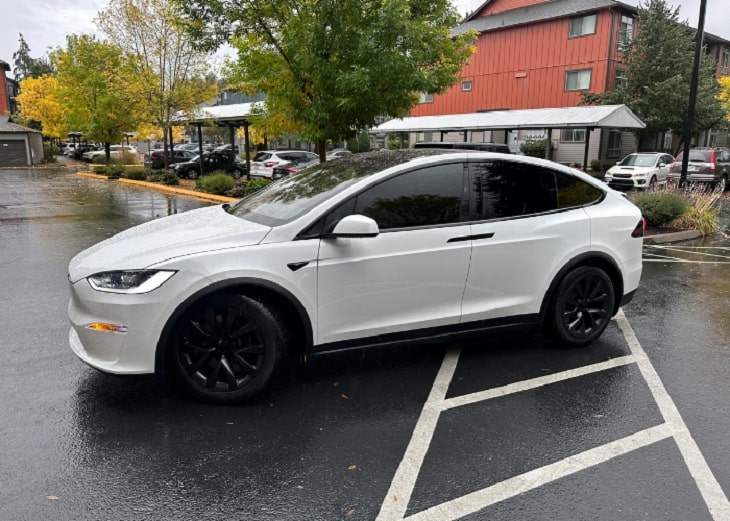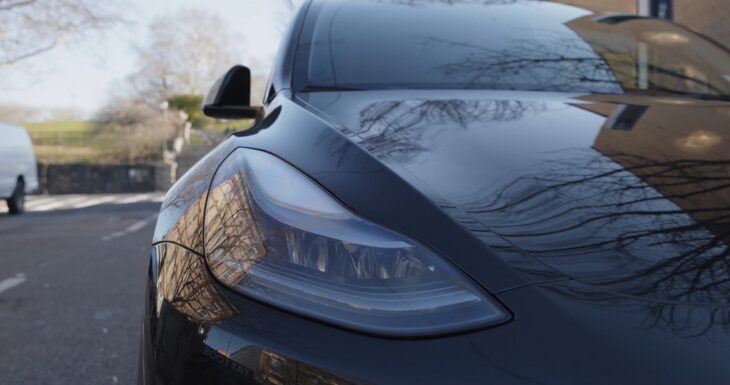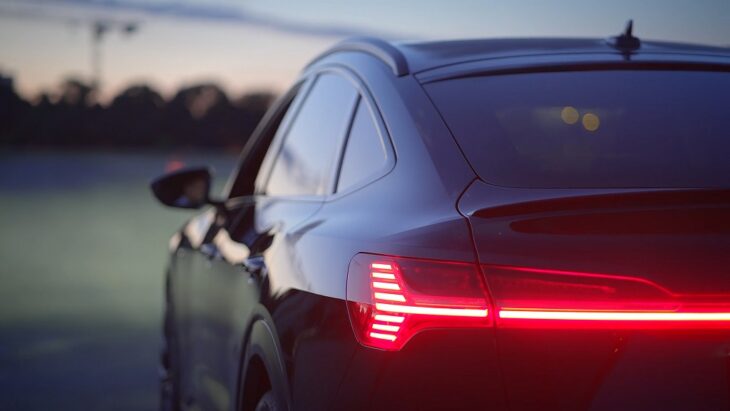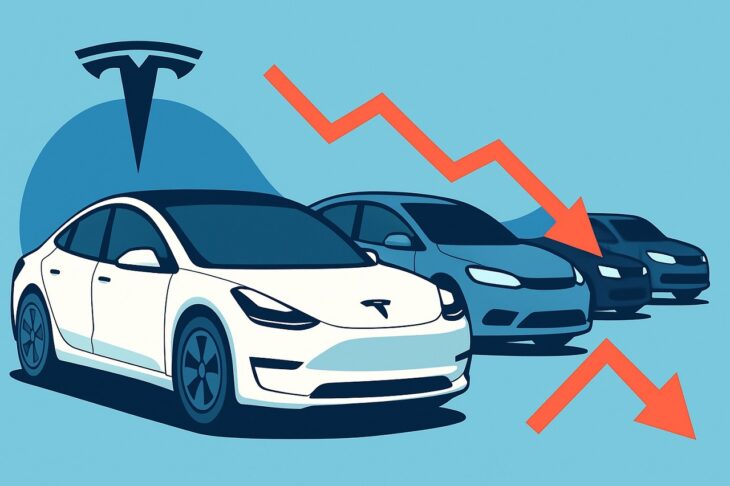Tesla changed how people think about electric vehicles. Dominance in EV innovation, performance, and branding made the company the benchmark in the auto industry for over a decade. The purpose now is to analyze Tesla’s current position amid intensifying global competition and evolving consumer behavior.
As automakers adapt quickly and customer expectations shift, one key question emerges: Is Tesla still leading car sales in 2025 or slowly losing its grip?
Table of Contents
ToggleThe Numbers Behind Tesla’s Recent Struggles

Tesla’s financial footing in 2025 shows growing instability. Performance in Q1 shocked analysts, with net income plunging by 71%. That kind of contraction sent tremors through Wall Street, where faith in Tesla had been remarkably resilient for over a decade.
Since December 2024, share prices have dropped over 40%, revealing shaken investor trust and flagging optimism about the company’s growth trajectory. In Europe, the situation echoes the broader downturn. New Tesla car registrations have dropped 45.2% across the EU.
That decline doesn’t exist in a vacuum; it reflects changing consumer preferences and broader market forces. Buyers are now prioritizing affordability, service accessibility, and vehicles made by manufacturers with regional roots.
 You will find more infographics at Statista
You will find more infographics at StatistaKey indicators of financial and market stress include:
- 71% drop in net income (Q1 2025)
- Over 40% decline in stock value since December 2024
- 45.2% fall in new EU Tesla vehicle registrations
Those figures do not simply suggest a slump; they point to a fundamental challenge in keeping pace with consumer expectations, evolving market conditions, and rising competition.
The Rise of Competitors

Tesla’s competitors are not catching up; they’re taking over market share. In the United States, major automakers like Ford and Chevrolet are gaining traction with accessible EV models and national marketing strength.
Rivian is building a niche of its own, appealing to adventure-oriented buyers and tech-savvy users alike with a design that feels bold and purpose-built.
Meanwhile, aftermarket specialists like silverstoneautospa.com cater to Tesla owners who still want to invest in their vehicles’ appearance and protection, offering high-end paint protection solutions that enhance resale value and maintain that showroom finish.
In the European EV market, Volkswagen has now overtaken Tesla, leveraging a strong network of dealerships, local subsidies, and familiarity with the regional consumer base. SAIC Motor, the Chinese automotive giant, has managed to deliver 88,475 electric vehicles in the EU alone, eclipsing Tesla’s 50,413.
Government policy favoring local or regional producers further amplifies this trend. Globally, BYD has emerged as the dominant EV force. Its aggressive pricing, large-scale production, and integration into public transportation infrastructure are boosting its reach in ways Tesla cannot currently match.
Evidence of mounting competition:
- Ford, Chevrolet, and Rivian are gaining in U.S. EV sales
- Volkswagen is now outselling Tesla in Europe
- SAIC Motor selling 88,475 EVs in EU vs. Tesla’s 50,413
- BYD is leading global EV sales across multiple segments
Tesla once led without question. Now, its competitors hold home-field advantages in almost every region. Innovation alone is no longer enough; responsiveness to local preferences, pricing sensitivity, and distribution agility matter more than ever.
Changing Consumer Sentiment and Political Baggage
Tesla’s public perception has taken a noticeable turn by 2025. A brand that once represented forward-thinking innovation and a cleaner future now finds itself navigating controversy and growing public skepticism.
Once celebrated for redefining electric mobility, Tesla now wrestles with cultural backlash that goes far beyond vehicle specs or battery performance.
Elon Musk’s increasingly vocal presence in political circles has become a central issue. Posts on social media platforms, public endorsements of political candidates, and confrontational statements have pushed the Tesla brand into contentious debates.
For a long time, Tesla managed to walk the line between cutting-edge technology and a political status, an object admired across ideologies. That neutrality has disappeared. Once the choice of tech-savvy professionals, environmental advocates, and image-conscious early adopters, Tesla now finds itself viewed through a different lens.
Car buyers are asking themselves what a Tesla says about them, not just as a driver, but as a person. Vehicle selection in today’s market reflects lifestyle, ethics, and community alignment.
Key areas where sentiment is shifting:
- Brand loyalty erosion is tied to Elon Musk’s public political behavior
- Loss of favor among progressives, moderates, and younger city-based consumers
- Brand identity complications are slowing international expansion efforts
Younger drivers, in particular, are moving away from Tesla. In cities known for progressive leanings, such as San Francisco, Seattle, Berlin, and Amsterdam, new EV buyers are opting for alternatives that match their ideals without added controversy. Buyers want clean transportation, not public drama.
Internationally, Tesla’s branding issues are compounded. In regions like Europe and Australia, Musk’s political involvement has been met with confusion, criticism, or both.
Negative press, backlash against social media activity, and growing concern over the brand’s alignment with controversial issues are all affecting consumer interest abroad.
Meanwhile, competitors like Hyundai, Kia, Ford, and BYD focus their messaging on affordability, sustainability, and reliability, without any public-facing distraction. These brands speak to practical concerns and values, while Tesla’s messaging increasingly mirrors its CEO’s online presence.
The gap between Tesla’s branding and consumer expectations continues to grow. Identity alignment matters, and many former loyalists no longer see themselves reflected in the Tesla image. That disconnect represents more than a PR issue; it’s a sales issue.
When public figures become inseparable from the products they lead, every post, comment, or endorsement carries financial consequences.
Broader Industry Trends

Automotive momentum in 2025 no longer revolves around Tesla’s product releases or announcements. Hybrid vehicles currently dominate EU sales, claiming 35.1% of the market.
Buyers are favoring vehicles that offer a middle ground, electric support without full dependence on limited charging infrastructure.
EV adoption rates are rising globally, but no longer in tandem with Tesla’s brand power. Instead, brands offering affordability, regional support, and scalable service win over the mass market. Charging access, maintenance convenience, and monthly payment options are shaping buyer decisions more than luxury branding.
In Europe, regional behavior reveals disparity:
- Spain shows consistent EV sales growth
- France faces declining EV interest due to reduced government incentives and higher energy costs
Broader market characteristics:
- Hybrids leading in European sales (35.1%)
- No single automaker defines EV trends
- Increased importance of local strategy and adaptability
Tesla’s strategy, built on global uniformity and brand strength, is becoming mismatched with the current climate.
Manufacturers tailoring vehicles and policies to each region are reaping rewards. Tesla must now evolve from industry disruptor to adaptive contender in a more competitive, fractured EV world.
The Bottom Line
Tesla remains an important figure in the EV world. However, 2025 makes it clear that success in electric mobility no longer belongs to a single company. Performance slumps, rising competition, political missteps, and shifting market preferences have all chipped away at Tesla’s dominance.
Regional players in Europe and China are proving more agile and culturally aligned with local buyers. Global EV growth continues, but it’s no longer Tesla-driven.
What began as a revolution now enters a new phase. Leadership depends on more than innovation; it demands responsiveness, humility, and broad-based trust. Tesla’s future will depend on adapting, not just reminiscing on past triumphs.



